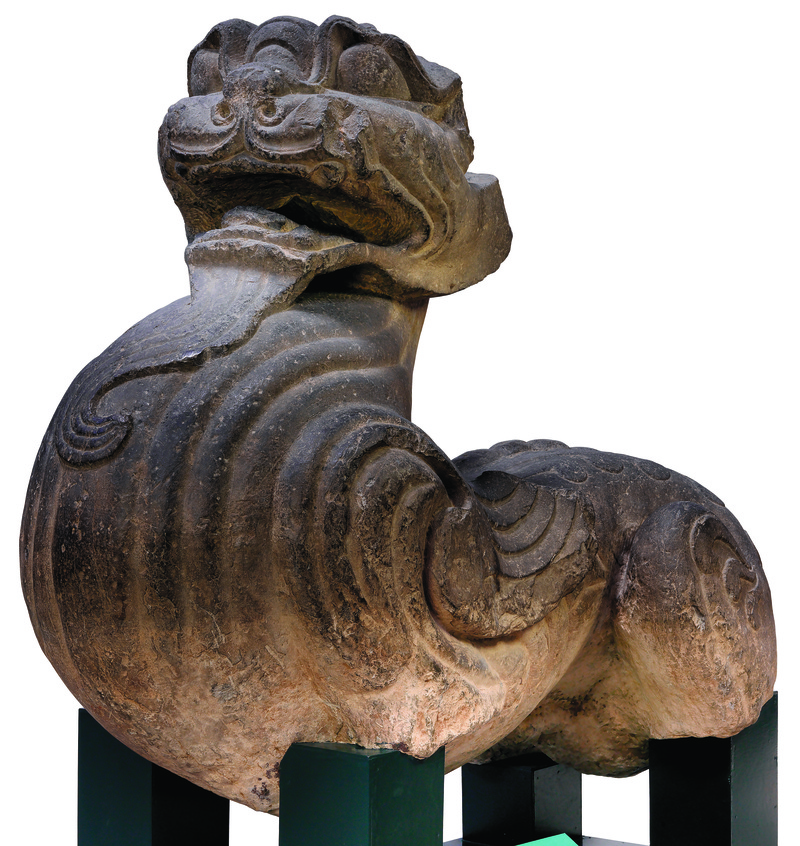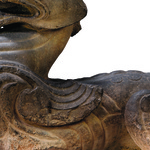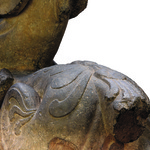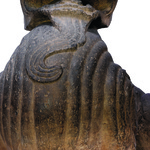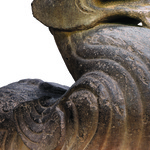Statue
C656
Location: On Display in the Asia Galleries
From: China | Hebei | Neiqiu County
Curatorial Section: Asian
View All (14) Object Images
Remove From My Finds -
Object Number
C656
Current Location
Asia Galleries - On Display
Culture
Chinese
Provenience
China | Hebei | Neiqiu County
Period
Han Dynasty
Date Made
ca. 200 CE
Section
Asian
Materials
Stone
Technique
Carved
Iconography
Winged Lion
Description
One of a pair of colossal stone winged lions (C656 and C657). The winged lion is a mythical animal primarily containing lion and dragon features. They are often placed in pairs at the beginning of a pathway that leads to a burial mound. Depicted in a running motion, this male lion and its female counterpart demonstrate strength and power through emphasis on muscle. It was believed that they would enhance the dignity of the tomb, glorify the memory of the deceased and protect against evil spirits. This piece has one horn and a beard falling onto its chest. The legs, tail, and ears are broken and partly missing.
Height
152.4 cm
Length
208.3 cm
Width
78.4 cm
Credit Line
Purchased from C. T. Loo, 1927
Current & Past Exhibitions
Bibliography
Smith, Adam D., and Zhongpei Qin. "Marking the Spirit Road: Funerary Stone Sculpture in China ." Expedition: The Magazine of the University of Pennsylvania Museum of Archaeology and Anthropology 59, no. 3. (2017): 26-37.
View related objects
Till, Barry. "Some Observations on Stone Winged Chimeras at Ancient Tomb Sites." Artibus Asiae 42, no. 4. (1980): 261-281. See: Fig. 14a,b
View related objects
Horne, Lee C. Introduction to the Collections of The University Museum . Philadelphia: The University Museum, 1985. Page/Fig./Plate: 59
View related objects
Jayne, Horace H. "The Chinese Collections of The University Museum: A Handbook of the Principal Objects ." The University Museum Bulletin 9, no. 2-3. (1941): 9-50. See: Fig. 3
View related objects
Jayne, Horace H. "Chinese Art at the University Museum." Parnassus 11, no. 1. (01 Jan 1939). See: Illustration
View related objects
March, Benjamin. China and Japan in our Museums . New York: American Council, Institute of Pacific Relations, 1929. Page/Fig./Plate: 87
View related objects
Siren, Osvald. "Winged Chimeras in Early Chinese Art." Eastern Art I, No. 2. (1928): 86-96. Page/Fig./Plate: 86-96, Plates 9, 10
View related objects
Fernald, Helen E. "Two Colossal Stone Chimeras from A Chinese Tomb ." The Museum Journal XVIII, No. 2. (1927): 159-173. Page/Fig./Plate: 159-173
View related objects
Report problems and issues to digitalmedia@pennmuseum.org .


